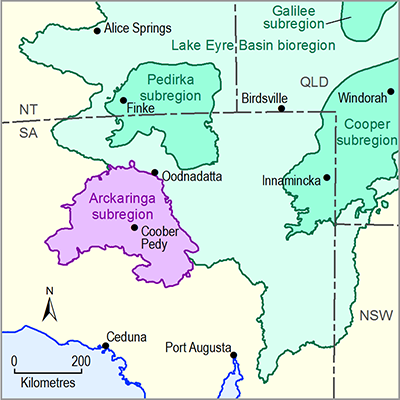The development of conceptual models describing the hydrodynamics and flow characteristics of groundwater systems in sedimentary basins such as the Arckaringa Basin as well as determining the economic potential of any coal resources, require an understanding of their structural and tectonic history. Such an understanding provides important insights into the origins of basin architecture, deformation responsible for the development of sub-basins or preferential flow paths and the origins of sedimentary successions. The following provides a brief summary of pertinent information concerning the structural and tectonic history of the Arckaringa subregion.
After the amalgamation of a number of Archean cratons to form the Australian continent (Powell and Pisarevsky, 2002; Powell et al., 1993), a series of tectonic events commencing in the Late Proterozoic occurred. These events predominantly affected zones of lithospheric weakness associated with the margins of cratonic elements and were responsible for the development of the basic structural architecture and basinal development linked with the Arckaringa Basin.
During the Late Proterozoic to Early Phanerozoic, plate divergences formed complex continental margins. The inception of a number of basins have been interpreted as failed rift arms of deeply penetrating triple rift junctures that formed along these plate margins. Such basins include (but are not restricted to) the Officer and Warburton basins (Questa, 1990).
The Delamerian Orogeny that occurred during the Late Cambrian was associated with a number of west-north-west compressive tectonic events that produced north trending thrusts, north-west trending transgressive shears, recumbent folds, igneous intrusions and metamorphism (Cotton et al., 2006) as well as inverting parts of the Adelaide Geosyncline. Preiss (2000) interpreted five major successive rift cycles, each with its own locus and orientation, in relation to deformation events. Cotton et al. (2006) also suggested that the deep crustal scale, length and planar form of these structures were favourable for reactivation during later phases of tectonism.
Cotton et al. (2006) suggested that the structural grain of the Permo-Carboniferous basins of central Australian (Cooper, Pedirka and Arckaringa) were influenced by north-west orientated compression and uplift associated with the Alice Springs Orogeny that occurred during the Devonian and Carboniferous. This event re-activated a number of east-trending Proterozoic structures (ca. 1.0 Ga) associated with the Musgrave Block in north-west SA and the Albany Fraser belt in neighbouring WA (Karlstrom et al., 2013). Gravestock and Sansome (1994), described crustal shortening of up to 20 km and uplift of 3 km as a consequence of this event. Over-thrusting during this period resulted in the formation of many of the domal trends that controlled the position of depocentres for Permo-Carboniferous sedimentation (Karlstrom et al., 2013).
Menpes et al. (2010) and Menpes (2012) argued that trough-formation within the Arckaringa Basin was dominated by glacial processes. The location and orientation of these glacial valleys appears to have been controlled by pre-existing structural grain and rock types in the underlying basement. Minor contraction coincident with deposition culminated in gentle folding of the Early Permian succession, uplift and erosion. Cotton et al. (2006) suggested that syn-depositional faulting occurred during the Early Permian. Shearer (1994) stated that the north-east faults have not been re-activated post-Permian, whereas the north-west fault system has been re-activated.
Deposition in the Arckaringa Basin appears to have ceased during the Sakmarian (Early Permian) on the basis of palynological data (Alley, 1995; Menpes, 2012). Menpes et al. (2010) and Menpes (2012) have suggested that this break in deposition may correlate with breaks in deposition within the Patchawarra Formation, or alternatively may be related to the Daralingie Unconformity between the Early and Late Permian identified in the Cooper Basin.
PIRSA (2010) estimated that between 500 m and 1000 m of the Mount Toondina section was removed prior to the deposition of Mesozoic sediments. Compression and uplift events during the Early Cenozoic (approximately 50 Ma) and in the last 15 to 5 Ma have caused deformation of Permo-Carboniferous sedimentary rocks, as well as terminating periods of sedimentation associated with the Mesozoic and Cenozoic respectively (Senior and Habermehl, 1980; Toupin et al., 1997, Karlstrom et al., 2013; Questa, 1990).
With respect to thermal history, analyses of organic-rich Permian shale samples from exploration holes Arkeeta 1, drilled within the Phillipson Trough in the southern Arckaringa Basin and Arck 1, drilled within the Boorthanna Trough, display Type II (oil and gas prone) and Type I/II (oil prone/ oil and gas prone) kerogen source rocks respectively at or near the onset of oil generation (DMITRE, 2012) (Figure 20). Kerogen is complex, fossilised organic material present in sedimentary rocks that may be converted to petroleum under the correct pressure and temperature conditions.

Product Finalisation date
- 1.1.1 Bioregion
- 1.1.2 Geography
- 1.1.3 Geology
- 1.1.4 Hydrogeology and groundwater quality
- 1.1.5 Surface water hydrology and surface water quality
- 1.1.6 Surface water – groundwater interactions
- 1.1.7 Ecology
- Citation
- Acknowledgements
- Contributors from the Government of South Australia
- Contributors to the Technical Programme
- About this technical product
